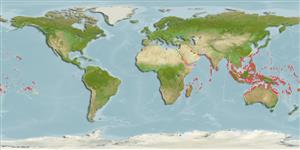Common names from other countries
Environment: milieu / climate zone / depth range / distribution range
Écologie
Récifal; profondeur 3 - 10 m (Ref. 98622). Tropical; 30°N - 34°S, 27°E - 135°W (Ref. 846)
Indo-Pacific. Tropical to subtropical.
Length at first maturity / Taille / Poids / Âge
Maturity: Lm ? range ? - ? cm Max length : 19.9 cm BRL mâle / non sexé; (Ref. 269); common length : 2.5 cm BRW mâle / non sexé; (Ref. 269)
Description synthétique
Morphologie
A corymbose growth form distinguishes this spcies. Individual branches form fat fingers, 0.1-0.25 cm in diameter and less than 20 cm in length, with little secondary branching. Due to solid construction, these species is found on exposed reefs throughout its range in shallow to intermediate depths (Ref. 269).
Life cycle and mating behavior
Maturité | Reproduction | Frai | Œufs | Fécondité | Larves
Hermaphroditic (Refs. 113708, 113712). Mature gametes are shed into the coelenteron and spawned through the mouth. Life cycle: The zygote develops into a planktonic planula larva. Metamorphosis begins with early morphogenesis of tentacles, septa and pharynx before larval settlement on the aboral end (Ref. 833).
Wallace, C.C. 1999. (Ref. 86439)
Statut dans la liste rouge de l'IUCN (Ref. 130435: Version 2024-1)
statut CITES (Ref. 108899)
Not Evaluated
Utilisations par l'homme
| FishSource |
Outils
Sources Internet
Estimates based on models
Preferred temperature
(Ref.
115969): 24.9 - 29.3, mean 28.4 (based on 3133 cells).
Vulnérabilité
Low vulnerability (10 of 100).
Catégorie de prix
Unknown.
